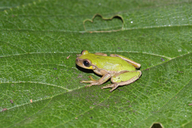|
Sarcohyla cyclada (Campbell & Duellman, 2000)
| family: Hylidae subfamily: Hylinae genus: Sarcohyla |
| Species Description: Campbell, J.A. and Duellman, W.E. 2000. New species of stream-breeding hylid frogs from the northern versant of the highlands of Oaxaca, Mexico.Scientific papers of the Natural History Museum of the University of Kansas: 1-28. | |
 © 2010 Sean Michael Rovito (1 of 5) |
|
|
|
Description The tadpole for this species was originally illustrated in Duellman (1970) as Hyla arborescandens. Only tadpoles at Gosner (1960) Stage 25 are known. Similar to H. arborescandens in the presence of two rows of small marginal papillae, absence of submarginal papillae, presence of fine serrations on the beaks, and a denticle formula of 2/4. Distribution and Habitat Country distribution from AmphibiaWeb's database: Mexico
Life History, Abundance, Activity, and Special Behaviors
References
Caldwell, J. P. (1974). ''A re-evaluation of the Hyla bistincta species group, with descriptions of three new species (Anura: Hylidae).'' Occasional Papers of the Museum of Natural History, University of Kansas, 28, 1-37. Campbell, J. A., and Duellman, W.E. (2000). ''New species of stream-breeding hylid frogs from the northern versant of the highlands of Oaxaca, Mexico.'' Scientific Papers of the Natural History Museum of the University of Kansas, 16, 1-28. Duellman, W.E. (1970). The Hylid Frogs of Middle America. Monograph of the Museum of Natural History, University of Kansas. Gosner, K. L. (1960). ''A simplified table for staging anuran embryos and larvae with notes on identification.'' Herpetologica, 16(3), 183-190. Mendelson, J. R., III, and Toal, III, K.R. (1996). ''A new species of Hyla (Anura: Hylidae) from the Sierra Madre del Sur of Oaxaca, Mexico, with comments on Hyla chryses and Hyla mykter.'' Journal of Herpetology, 30, 326-333. Toal, K. R., III, and Mendelson, J.R., III (1995). ''A new species of Hyla (Anura: Hylidae) from cloud forest in Oaxaca, Mexico, with comments on the status of Hyla bistincta group.'' Occasional Papers of the Museum of Natural History, University of Kansas, 174, 1-20. Toal, K.R., III. (1994). ''A new species of Hyla (Anura: Hylidae) from the Sierra de Juarez, Oaxaca, Mexico.'' Herpetologica, 50, 187-193. Originally submitted by: Raul E. Diaz (first posted 2004-06-04) Edited by: Tate Tunstall (2004-08-18) Species Account Citation: AmphibiaWeb 2004 Sarcohyla cyclada <https://amphibiaweb.org/species/6270> University of California, Berkeley, CA, USA. Accessed May 31, 2025.
Feedback or comments about this page.
Citation: AmphibiaWeb. 2025. <https://amphibiaweb.org> University of California, Berkeley, CA, USA. Accessed 31 May 2025. AmphibiaWeb's policy on data use. |



 Map of Life
Map of Life